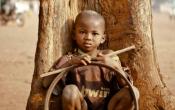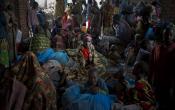Democratic Republic of the Congo Regional Office
Operation: Democratic Republic of the Congo Regional Office
Location
{"longitude":22,"latitude":-4,"zoom_level":5}
Latest update of camps and office locations 13 Jan 2016. By clicking on the icons on the map, additional information is displayed.
Key Figures
| 2015 end-year results | |
| 133,000 | protection incidents were recorded in 2015, of which 10,400 were related to sexual and gender-based violence (SGBV) |
| 78% | of Burundian refugee children were enrolled in primary education |
| 45% | of CAR refugee children were enrolled in primary education |
| 45% | of CAR refugees had access to latrines |
| 33% | of Burundian refugees had access to latrines |
| 74% | of Burundian refugees resided in adequate dwellings, while shelter and infrastructure were improved and maintained |
| 97% | of CAR refugees resided in adequate dwellings, while shelter and infrastructure were improved and maintained |
| 2016 planning figures | |
| 30,820 | registered children targeted to be enrolled in primary education |
| 16,470 | people of concern targeted to receive long-term/permanent shelter |
Latest Updates and Related Links
Last Updated 13 September 2016
People of Concern
25%
Decrease in
2015
2015
| 2015 | 2,701,921 |
| 2014 | 3,619,785 |
| 2013 | 3,817,537 |

[["Refugees",384038],["Asylum-seekers",2924],["IDPs",1555112],["Returned IDPs",736837],["Returned refugees",8536],["Others of concern",14474]]
Loading ...
Budgets and Expenditure for Democratic Republic of the Congo Regional Office
< Back
2015
{"categories":[2012,2013,2014,2015,2016],"budget":[157.672624547,196.62741826,196.1200685,207.82899884,203.88117243],"expenditure":[76.25272289,80.44026164,82.89793508,81.24654248,null]}
{"categories":[2012,2013,2014,2015,2016],"p1":[84.337626717,84.29544165,71.90779198,91.41104086,97.29890623],"p2":[1.02275178,1.76370934,1.64748057,2.69677526,1.923405],"p3":[22.3166671,24.57256446,47.12909081,38.54665211,29.81920304],"p4":[49.99557895,85.99570281,75.43570514,75.17453061,74.83965816]}
{"categories":[2012,2013,2014,2015,2016],"p1":[43.22165176,48.3141246,50.09923907,57.35459999,null],"p2":[0.51723528,1.40268682,0.79246867,0.72133408,null],"p3":[8.24604447,12.22476921,16.65508797,10.2698795,null],"p4":[24.26779138,18.49868101,15.35113937,12.90072891,null]}
Loading ...
CHOOSE A YEAR
- 2014
- 2015
- 2016
Working environment
- Biometric registration planned for Rwandan refugees in the Democratic Republic of the Congo (DRC) had to be suspended. In June 2015, owing to the insecurity in North Kivu, only 26,100 out of the 262,000 Rwandan refugees were registered biometrically. Also, out of the 20,000 Rwandan refugees that UNHCR had planned to assist during voluntary repatriation, only 5,193 repatriated.
- Ethnic tensions in the State of Western Equatoria, South Sudan, resulted in an influx of 3,800 South Sudanese refugees in Dungu territory in the district of Haut-Uele, DRC.
- Activities to assist and protect Burundian refugees were implemented through the existing community-based structure. Staff capacity in three public schools was reinforced around Lusenda camp, where 3,300 Burundian refugee students were enrolled.
- Five camps for refugees from the Central African Republic (CAR) were established in the North and South Ubangi districts. Refugees living in the camps and hosted in families received multisectorial assistance.
- Interagency coordination efforts enabled the return and relocation of hundreds of IDP families to the villages of their choice. Five IDP camps were subsequently closed.
Population trends
- The number of Central African Refugees increased by 39 per cent, from 68,200 to 108,000 by year end.
- After the crisis in April 2015, the number of Burundian refugees increased by 52 per cent, from 9,300 to 19,500.
- For the reasons highlighted above, the IDP population decreased by nearly 40 per cent from 2.7 to 1.6 million in the course of 2015.
Achievements and impact
- Just over 800 Congolese refugees safely repatriated from Zemio camp in the CAR.
- For Congolese returnees, UNHCR rehabilitated a school that hosted 122 repatriated children and organized two trainings sessions in cooperation with provincial divisions to reinforce the capacities of 77 teachers in the area of return.
- CAR refugees, who were survivors of SGBV, received psychological and legal support and benefitted from social and economic reintegration projects.
Unmet needs
- Refugees living in spontaneous settlements and along the border with the CAR continued to face protection risks because of logistical constraints and lack of physical access.
- The number of urban refugees doubled during the reporting period, which placed a heavy strain on limited resources and hindered assistance.
- With respect to food security, only 28 per cent of IDP needs were met. No more than 4 out of the 31 UNHCR coordinated IDP sites had shelter and construction services that assisted persons with specific needs.
Working environment
The Democratic Republic of the Congo (DRC) is characterized by ongoing conflict, poor or non-existent infrastructure and highly challenging logistics, all of which make access to refugees and other populations of concern quite difficult. Due mainly to the conflict in the eastern part of the country, approximately 430,000 refugees from the DRC remain in neighbouring countries, particularly Burundi, Rwanda, Uganda and the United Republic of Tanzania.As of August 2014, approximately 70,000 refugees from the Central African Republic (CAR) who sought refuge from the deteriorating situation in their country of origin benefitted from UNHCR’s protection and assistance activities in the DRC, in addition to refugees from Burundi and Rwanda.
The scale of displacement within and outside the DRC remains serious. There are some 2.7 million internally displaced people (IDPs) within the country in 2014 due to ongoing armed conflict in the east. UNHCR has the leading role in the protection cluster, as well as in the shelter cluster, and plays a significant role in the camp coordination and camp management (CCCM) cluster working groups.
Tripartite agreements for the voluntary repatriation of Congolese (DRC) refugees exist with neighbouring countries but ongoing insecurity hampers large-scale repatriation to the east of the DRC.
Needs and strategies
In 2015, refugees from the CAR will benefit from protection and multi-sectoral assistance in camps and host communities, where access permits. To reduce dependency on food aid, particular attention will be placed on promoting self-reliance and livelihoods activities. Starting with a nutritional survey to be conducted in June 2015, a differentiated strategy will be designed and pursued to reduce dependency, through the reduction of food assistance to refugees.The repatriation of Angolan refugees from the DRC is expected to end by 30 June 2015. Also, the local integration process for the remaining Angolan refugees will continue to be implemented, with a view to phasing it out by 2016.
Refugees will continue to be registered and to receive documentation that enhances their protection. The identification and implementation of appropriate durable solutions will also be the focus of UNHCR’s work in the DRC, while continuing to monitor permanent access to asylum and respect for the principle of non-refoulement for those who seek international protection. UNHCR will work with the Government and communities to minimize risks of sexual and gender-based violence (SGBV) and other human rights violations. With the authorities, it will also seek to assure the civilian character of asylum.
Through community outreach and work with civil society, UNHCR will also support community-based protection and greater self-reliance among urban refugee households with specific needs.
The Office will continue to seek durable solutions for Congolese (Republic of the Congo) and Rwandan refugees, within the framework of the existing tripartite agreements and the comprehensive strategy for the Rwandan refugee situation.
To advance the reintegration of DRC returnees, the Office will promote peaceful coexistence by conducting reconciliation and conflict-resolution activities in local communities, pursuing and encouraging the involvement of other UN agencies and development actors, while addressing basic education, health and shelter needs within a comprehensive protection framework.
UNHCR’s IDP strategy will be based on its efforts in assisting the Government to enact IDP legislation and, if possible, assist its implementation both technically and operationally together with all relevant actors in the country. UNHCR will also encourage community-based protection, in collaboration with the full range of partners, and support the development of a return-conducive environment. UNHCR’s coordination role in the protection cluster will continue to aim at strengthening protection activities, projects and advocacy efforts, with particular attention to protection of IDPs from SGBV and from the physical and psychological effects of conflict. UNHCR is part of a national strategy to combat SGBV, coordinating working groups to prevent SGBV and implementing the Safe Access to Fuel and Energy (SAFE) approach.






